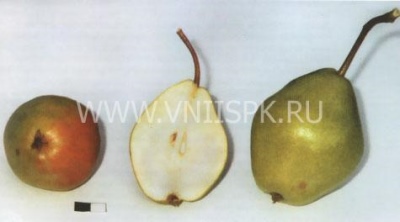
- Authors: Sverdlovsk Horticultural Selection Station, L.A. Kotov, G.N. Tarasova
- Appeared when crossing: 2-39 x Firstborn
- Year of approval: 2004
- Fruit weight, g: 145-190
- Ripening terms: early autumn
- Fruit picking time: by September 1
- Appointment: universal
- Growth type: medium height
- Yield: good
- Transportability: good
Pear Dobryanka, or Sentyabrina, was created specifically for regions with difficult climatic conditions. The culture is not too whimsical to care for, while annually pleases with a bountiful harvest. The variety is especially attractive due to its excellent taste and early ripening.
Breeding history
The variety was bred by domestic breeders L. A. Kotov and G. N. Tarasova on the basis of the Sverdlovsk gardening selection station. It was approved for use in 2004. The plant was obtained by crossing 2-39 and Firstborn.
Description of the variety
The tree is medium-sized, the maximum height of an adult plant does not exceed 3-4 meters. Young seedlings are fast growing. The crown of the variety is broadly pyramidal and slender. There is no need to form it, since it does not self-thicken. Dobryanka's branches grow at an obtuse angle, and an arched type of growth is inherent in them. Young shoots are olive green, the trunk bark is dark gray. They are straight, with medium-length internodes.
There are a moderate amount of large leaves on the tree. They are shiny and dark green in color, broadly lanceolate in shape. The buds on the shoots are formed with a strong deviation, which makes the tree look curly. The fruits are formed on spears and ringlets.
Fruit characteristics
The appearance of the fruit is attractive. The average weight of one pear is 145-190 grams. Their shape is lemon-pear-shaped, slightly elongated, one-dimensional. The surface is smooth. The main color of the fruit is dark green, with late ripening it becomes yellowish-green. The dull skin is dry. Pears ripen on strong stalks. Therefore, the ripe crop is not crumbled.
Taste qualities
Dobryanka has a balanced sweet and sour taste. The pulp is very juicy and tender, yellowish in color, with few seeds. On a five-point tasting scale, the variety is rated at 4.7-4.8 points.
The fruits have a universal purpose. It is widely used fresh. They also make delicious jams, compotes, juices, dried fruits and even wines. Due to its good yield, transportability and keeping quality, Dobryanka is of great interest for growing on an industrial scale.
Ripening and fruiting
The culture begins to bear fruit at 4-5 years of development. Flowering occurs in mid-May and lasts 2-3 weeks. The variety is considered early autumn. The fruits ripen by September 1. Long-term fruiting. The crop is harvested within 30 days. If the summer is cool and rainy, then the ripening period is delayed from 1 week to 2.

Yield
The culture is high-yielding. Six-year-old specimens are capable of producing about 100 kg of delicious fruits from one tree. Fruiting is annual.
Self-fertility and the need for pollinators
For successful fruiting, the tree needs cross-pollination. The best pollinators are such varieties as Rogneda, Michurinskaya Krasavitsa, Severyanka and Favoritka.
Landing
Special attention should be paid to planting in order to guarantee the rooting of the seedlings. Only healthy and strong bushes without signs of disease are planted.It is recommended to give preference to seedlings with a closed root system. Dobryanka pear tolerates frost well, but it is better to cover young trees with protective material for the winter.
They start planting in spring or autumn. The landing pit is prepared in advance. Its depth depends on the volume of the root system. Drainage is laid at the bottom in the form of crushed stone or broken bricks. The nutrient layer should consist of garden soil, sand, wood ash, compost or humus. And you can also add mineral fertilizers when planting. At first, the seedlings are watered abundantly, the soil is loosened to improve air exchange.


Growing and care
The culture has good immunity to most fungal infections. Quite high scab resistance. However, one should not neglect the preventive treatment of the tree with fungicides in the spring. Watering is moderate, but abundant irrigation is required during the period of active growth, flowering and laying of ovaries.
Watering must be increased when the weather is dry. Regular mulching allows you to retain the necessary moisture in the soil. Top dressing is applied every year. But if the planting was carried out correctly, then the first few years you will not have to make additional food.
Pruning is done as needed. The culture slightly thickens the crown. Be sure to remove dried, broken, with signs of disease shoots.




Like any other fruit trees, the pear needs protection from various diseases and pests. When planting a pear on your site, you need to know in advance what diseases you should beware of. To successfully carry out the struggle, it is necessary first to correctly identify the cause of the problem. It is important to distinguish signs of disease from manifestations of the presence of insects, mites, caterpillars and other types of pests.





































































